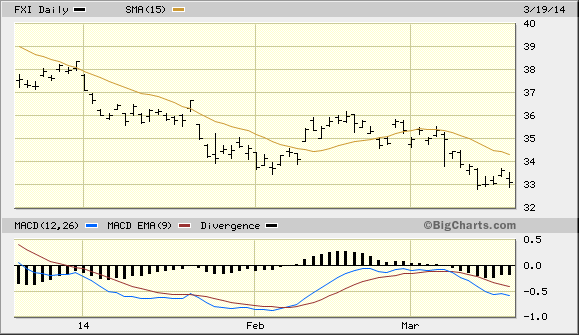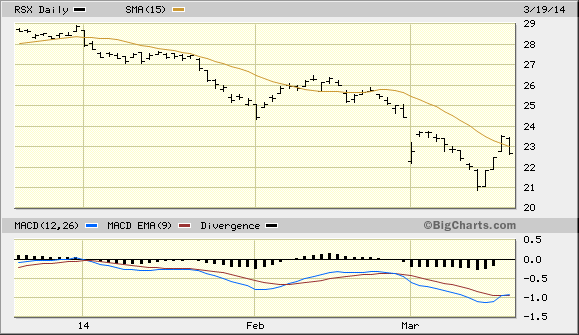Investors
dodged another bullet recently as geopolitical instability temporarily subsided
after Russia’s annexation of Crimea.
Although U.S. equities have experienced an internal correction since
then, most of the damage has been relegated to over-extended tech stocks that
were in need of a pullback.
A
reflection of the recent lifting of selling pressure on Russian equities can be
seen in the daily chart for the Market Vectors Russia ETF (RSX), a proxy for
Russia’s stock market. RSX has rallied
10 percent off its year-to-date low and is now above the 15-day moving average
to signal at least a temporary break of the immediate-term downtrend.
Wall
Street’s concern with China’s slowing economy has also diminished from earlier
this month and is reflected in the 4 percent rally of the Shanghai Composite
Index recently. With China, Russia and
the emerging markets on the backburner, equity investors should enjoy a
temporary respite of worries until at least later this spring. While U.S. stocks are under mild selling
pressure right now, the fact that the S&P 500 Index (SPX) is hovering close
to its highs despite the correction in growth stocks suggests that the bulls
haven’t yet given up their control over the market. A “spring fling” to new highs can’t be ruled
out before the final descent of the long-term deflationary cycle makes its
presence known.
Maybe not in the next couple of months, but certainly by the
summer we should see signs of increasing market volatility and accelerating selling
pressure, especially as we head closer to the final bottom of the 60-year
deflationary cycle this fall. If China
and/or other emerging market countries are experiencing turmoil at that time,
it will only serve to exacerbate the volatility.
Speaking of China, it’s worth noting that Goldman
Sachs Group has warned that financing arrangements in China using commodities
to obtain credit may unwind in the next 12 to 24 months. The unwinding would likely be driven by
increased volatility in the yuan currency, according to Goldman. The unwinding would be bearish “given
relatively limited physical liquidity to absorb the shock,” Goldman’s chief
commodities analyst Jeffrey Currie wrote.
Already we’ve seen preliminary signs of what the next global
market crisis could look like. The
problems have originated in China and Russia with other countries (e.g. Brazil,
Chile, Turkey) playing supporting roles.
This is very similar to what happened in 1998 with the financial crisis
that rolled across the globe beginning with Asia and extending to South
America, Russia and finally hitting the U.S. like a tsunami. Few market analysts in 1998 (a super boom
year) believed the “Asian contagion” would infect U.S. markets, but they were
dead wrong. It happened very quickly in
’98 with most of the damage occurring in July through September – the final
“hard down” phase of the 4-year and 8-year cycles. Not coincidentally, 2014 is also a bottom
year for the 4/8-year cycles as well as several others.
Contrary
to Wall Street’s expectations, global market volatility is still a prime
consideration for stocks in the intermediate-term. China’s slowing economy may come to exert a
significant drag on global equities as the year progresses, and Russia will
remain the proverbial powder keg until the Ukraine situation has been fully
resolved. Until then, investors are
advised to fasten their seatbelts as there will likely be increasing turbulence
this summer.
Again, this summer the 4-year, 8-year, 10-year, 12-year, etc.
cycles through the 60-year cycle will also be cascading into their final
bottoms around late September/early October.
It would be surprising indeed if the financial market somehow emerged
unscathed by this crescendo, especially given the fragile state of the global
economy.
















